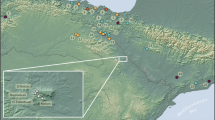Abstract
This study investigates bone stable isotopes from pigs from medieval York, to characterise the pigs' diet and to explore their contribution to isotopic values from contemporary human bones. Pig bones from the Swinegate (N = 9) and Coppergate (N = 14) sites were used for carbon and nitrogen stable isotope analysis to test the hypothesis that the majority of pigs in medieval York were yard-kept and fed on scraps and fish waste, elevating their nitrogen ratios. The results show that the Swinegate and Coppergate pigs gave nitrogen isotope values similar to contemporary sheep and therefore that animal protein made little or no dietary contribution. One sample showed C and N results consistent with more animal protein in the diet, and we propose that this could have been a yard-kept pig consuming human refuse. The majority of the data indicate that the pigs were eating a largely herbivorous diet and that pigs in medieval York may have been raised in rural or woodland locations rather than in the city.






Similar content being viewed by others
References
Bogaard A, Heaton THE, Poulton P, Merbach I (2007) The impact of manuring on nitrogen isotope ratios in cereals: archaeological implications for reconstruction of diet and crop management practices. J Archaeol Sci 34:335–343
Cooper J (2011) Stable isotope investigation of sheep mandibles from Coppergate, York. Unpublished BSc dissertation, Department of Archaeology, University of York
Hamilton J, Thomas R (2012) Pannage, pulses and pigs: isotopic and zooarchaeological evidence for changing pig management practices in later medieval England. Medieval Archaeology 56:234–259
Longin R (1971) New method of collagen extraction for radiocarbon dating. Nature 230:241–242
Millard AR, Jimenez-Cano NG, Lebrasseur O, Sakai Y (2011) Isotopic investigation of animal husbandry in the welsh and English periods at Dryslwyn castle, Carmarthenshire, Wales. Int J Osteoarchaeol, Early View, John Wiley and Sons. doi:10.1002/oa.1292. Accessed 30 Dec 2011
Müldner G, Richards MP (2005) Fast or feast: reconstructing diet in later medieval England by stable isotope analysis. J Archaeol Sci 32:39–48
Müldner G, Richards MP (2007a) Stable isotope evidence for 1500 years of human diet at the city of York, UK. Am J Phys Anthropol 133:682–697
Müldner G, Richards MP (2007b) Diet and diversity at later medieval Fishergate: the isotopic evidence. Am J Phys Anthropol 134:162–174
O'Connor TP (1989) Bones from Anglo-Scandinavian levels at 16–22 Coppergate. Archaeology of York 15/3. Council for British Archaeology, London
O'Connor TP (2000) Bones as evidence of meat production and distribution in York. In: White E (ed) Feeding a city: York. The provision of food from Roman times to the beginning of the twentieth century. Prospect Books, Devon, pp 43–60
Richards MP, Hedges REM (1999) Stable isotope evidence for similarities in the types of marine foods used by late Mesolithic humans at sites along the Atlantic coast of Europe. J Archaeol Sci 26:717–722
Acknowledgments
The investigation reported here was undertaken by CH as a BSc dissertation project, supervised by TPOC. Both authors contributed to the writing of this paper. We thank York Archaeological Trust for access to the specimens and for permission to sample, Andrew Gledhill and the University of Bradford for undertaking the isotopic measurements and Oliver Craig and Michelle Mundee for useful discussion of this project and our results.
Author information
Authors and Affiliations
Corresponding author
Rights and permissions
About this article
Cite this article
Hammond, C., O’Connor, T. Pig diet in medieval York: carbon and nitrogen stable isotopes. Archaeol Anthropol Sci 5, 123–127 (2013). https://doi.org/10.1007/s12520-013-0123-x
Received:
Accepted:
Published:
Issue Date:
DOI: https://doi.org/10.1007/s12520-013-0123-x




